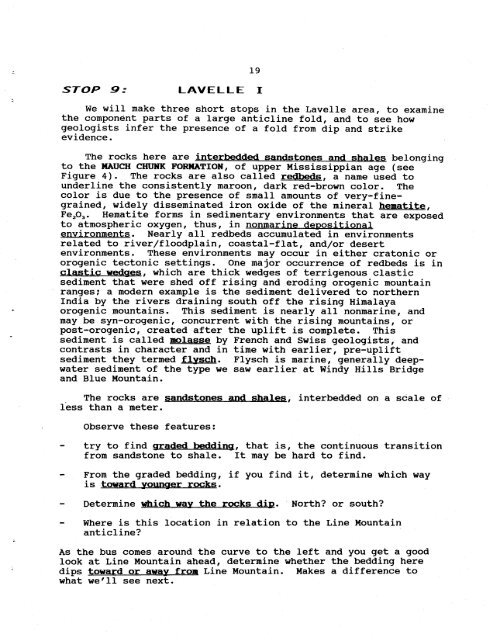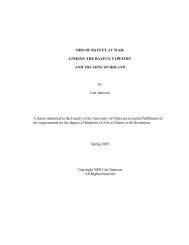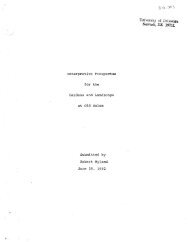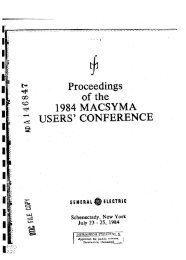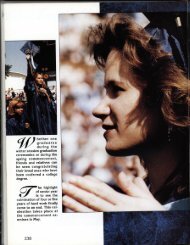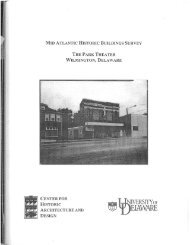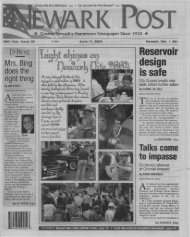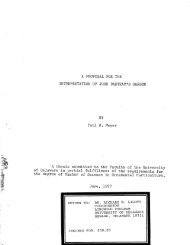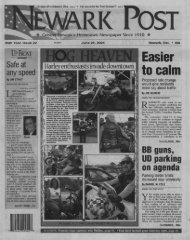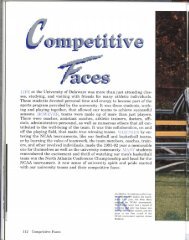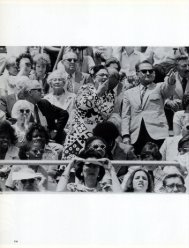FTELD TRIP ACROSS THE APPALACHTAN OROGENIC BELT
FTELD TRIP ACROSS THE APPALACHTAN OROGENIC BELT
FTELD TRIP ACROSS THE APPALACHTAN OROGENIC BELT
You also want an ePaper? Increase the reach of your titles
YUMPU automatically turns print PDFs into web optimized ePapers that Google loves.
STOP 9:<br />
l_9<br />
LAVELLE I<br />
We will make three short stops in the Lavelle area, to examine<br />
the component parts of a large anticline ford, and to see how<br />
geologists infer the presence of a fold from dip and strike<br />
evidence.<br />
The rocks here are interbedded sandstones a4d shales belonging<br />
to the I{AUCH CHtIl[K FORIIATIOil, of upper Mississippian age (see<br />
Figure 4). The rocks are also called redbeds, a name used to<br />
underline the consistently maroon, dark red-brown color. The<br />
color is due to the presence of snall amounts of very-finegrained,<br />
widely disseninated iron oxide of the mineral henatite,<br />
FerOr. Hematite forns in sedimentary environments that are exposed<br />
to atmospheric oxygen, thus, in nonnarine deBositional<br />
environments. Nearly all redbeds accumulated in environments<br />
related to river/floodplain, coastal-flat, and/or desert<br />
environments. These environments may occur in either cratonic or<br />
orogenic tectonic settings. One major occurrence of redbeds is in<br />
clastic sedgres, which are thick wedges of terrigenous clastic<br />
sediment that were shed off rising and eroding orogenic mountain<br />
rangesi a modern example is the sediment delivered to northern<br />
India by the rivers draining south off the rising Hinalaya<br />
orogenic mountains, This sediment is nearly a1I nonmarine, and<br />
may be syn-orogenic, concurrent with the rising mountains, or<br />
post-orogenic, created after the uplift is complete. This<br />
sediment is called molasse by French and Swiss geologists, and<br />
contrast,s in character and in tirne with earlier, pre-uplift<br />
sediment they termed flysch. Flysch is marine, generally deepwater<br />
sediment of the type we saw earlier at l{indy Hills Bridge<br />
and BIue Mountain.<br />
The rocks are sandstones and shales, interbedded on a siale of<br />
I'ess than a meter.<br />
Observe these features:<br />
try to find greded bedding, that is, the continuous transition<br />
from sandstone to shale. It may be hard to find.<br />
From the graded bedding, if you find it, determine which way<br />
is toward youngrer rocks.<br />
Deterrnine wtrich way the rocks dip. North? or south?<br />
Where is this location in relation to the Line Mountain<br />
anticline?<br />
As the bus comes around the curve to the teft and you get a good<br />
look at Line Mountain ahead, determine whether the bedding here<br />
dips toryard or away frou Line Mountain. ilakes a difference to<br />
what wet1l see next.


